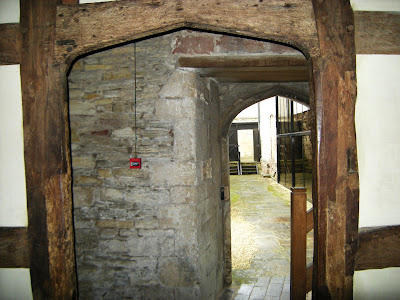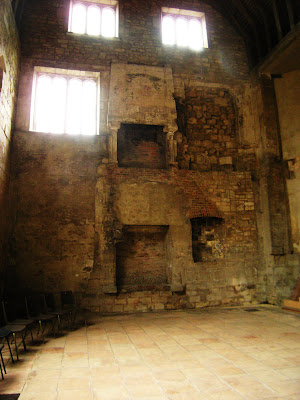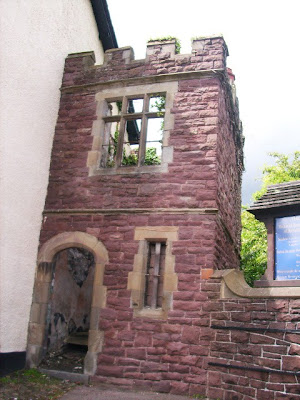
 ____________________________________
____________________________________LAVABO ARCHES (Washing facilities in this recess)















 ___________________________________________________
___________________________________________________Three Hundred Years of Caring for the People of Gloucester and the poor.
The Dominican Friars (Blackfriars) were in Gloucester for about three hundred years. Their teaching charism made them a much loved order and they had arrived in Oxford in 1221 and by 1239, the Friary in Gloucester was begun under the sponsorship of King Henry III. Of all the friaries in Britain, it remains the most complete mediaeval friory and Gloucester Council and English Heritage have been instrumental in reclaiming the land and buildings around the cloister and buying and demolishing unsuitable buildings like the 'Clutch Centre' and restoring the Friary. The 'Clutch centre' was built over the old 'Chapter House'and extended into the cloister green but has now been removed and will shortly be excavated .It had taken 40 years to complete the Blackfriars Buildings.
Henry III
Henry III was fond of Gloucester. It was the place of his Coronation (at St Peter's Abbey) when he was 9 yers old. His father, the unpopular King John (brother of Richard the Lion Heart (I) had lost the Crown Jewels and it was important the young king be crowned as soon as possible.The Friary was built in the Bailey of the Norman Castle in the town. The plague, as everything else reduced the numbers of people and friars.
Opus Dei
The Dominicans followed the normal hours of monastic life. Mattins(Morning Praise) in the early hours of the morning, lauds at 6am (approx)(Praises) Mass (approx 7.30),
Prime (9am) Angelus and Terce (12noon) 3pm (Nones) 6pm (Vespers-Evening Prayer) Compline (9pm) In between, there was study and work.The people of Gloucester greatly enjoyed the Dominican charism-Singing and sermons in the English language made it popular, as well as the interaction between the laity and the friars, particularly at Compline-popular with everyone, when the friars processed down from the quire, blessing the people with holy water and wishing them a restful night, and coming down to talk with the local people, and catechising them.It was a very successful order, reflected in the large size of the priory.
Newport, Hereford and Dominican Preachers
There was an old link between Newport (New Castle on the Usk) and Gloucester. The Normans had placed many of the monasteries , including that of St Woolos, and various other churches under the direction of the St Peter's Abbey in Gloucester. Also William, the second Earl of Gloucester , who succeeded to the lordship of Wentllwch in 1147 (+1183) first built the the new castle at old Newport.Following on from his tenure as Earl,all was well for a while, however, Henry III obviously used Newport as a base as he waged war against supporters of Simon de Montfort in Monmouthshire.He laid seige to Usk castle because Gilbert the Red, Lord of Wentllwch joined Simon de Montfort in his rebellion against the King for the forces of the barons. The Midlands, particularly Evesham were fighting ground for de Montfort .Monmouth Castle was destroyed by him, as it held out for the king. De Montfort occupied Newport Castle and in a furious battle, Prince Edward destroyed the ships at the mouth of the Usk, and Newport bridge was burnt in the process.However Gilbert the Red then married Joan,daughter of King Edward-and their son Morgan at Meredith, retains the lordship of Caerleon. These were turbulent times
The Austin Friars of Newport
It seems that, apart from the Austin or Augustinian Friars, whom we shall come to later, who were located on what is now Newport bus station and the new 'Friars' Walk' shopping Mall. I will leave this priory to one side for the moment, when I discuss the Augstinian foundations in Monmouthshire and Gloucester-The Austin Friars, the Augustinian Canons at the beautiful Llanthony Priory,and Llanthony Secunda at Gloucester for future posts.
When Sir Stephen de Herneshull and Henry III founded the Dominican house in Gloucester, it was a small house, but soon expanded, attracting a full complement of monks.The Historyof Gloucester (p494) tells us the house had no rents but their gardens were let out upon lease to help supplement their income, which was asmall evasion of their Rule. Another Dominican House was established during the time that St Thomas Cantelupe was Bishop around the same time.They set up a little oratory in Portgate in Inngate and then moved to the North subeurb when Sir John Daniel or D'Anveil built a new friary for them, later finished by Edward III.Prior Richard Barratt died here in 1351 or thereabouts and after being seized by Henry VIII it was sold off to an Elizabeth Wynne. So we have the Dominican houses to the North and North East of Newport. Given the close links between Newport and Gloucester(same overlord) it was probably Domenican preaching friars from Gloucester who were preaching, in English in Newport, according to their charism.
Since the Dominicans established a small oratory here , probably from Worcester or Gloucester (and I would welcome more information here!) it is natural to suppose that since the friars travelled out (as did the Franciscans) to preach to the laity, especially during the clement months of the year,that when Leland remarks on the 'Small house of the Friars Preacher'under the quay at Newport, it probably was one of these small oratories, and may not have been 'staffed' throughout the year.
I have asked myself why the Dominican Order did not develop in Newport, but believe the efforts of the Augustinians (who were actually closer to the Welsh church-many of the 'llans' became Augustinian in Norman times)were such in caring for the social and spiritual needs, that the Dominicans could confine themselves to their primary role of explaining the Word of God in English to the local people.In the early years the Augustianians were well supported financially by the Earl of Stafford Also Newport was never a wealthy town with wealthy benefactors. Certainly Leland was right, there was a small house of 'Friars Preachers' as,according to the records of Henry VIII's sales of the houses he had seized) Sir Edward Carn received this house.He also bought the Autin Friars, so no doubt paid for all of it. In fact, the friars may not have been permanently even in residence, although someone would have had to be there to hand it over. It seems that the Dominicans had to travel everywhere on foot to preach and needed to beg every morsel of food while away from the monastery as laid down by St Dominic.The 'house below the quay' has not been found, but more information is required here.
The Prior's House
Our tour took us firstly to the Prior's House, a small house at the side of the vestry and sanctuary. A Staircase used to rise from the sanctuary area to the friars' dorter which was above the vestry and Prior's appartments. The vestry is ruined at present but the site of the Chapter House awaiting excavation, as is the car park in front of Blackfriars. It was explained that the priors had a great deal of travel to do and consequently someone very fit was usually elected , as remember they had to travel on foot-to France once a year and also then to Oxford to the General English meeting usually in Oxford, or a designated place.
The Priors' house seemed to have two rooms, both had fireplaces which would have heated the dorter (monks' dormitory) upstairs.One room still has a beautiful painting(although parts of the image have been lost)and seems to be of the Blessed Virgin Mary and the Child Jesus.You can clearly see a banner and green shoots and leaves.There also seems to be a bread oven in one corner,which many have been a later addition by those who had later possession of the house after it had been taken from the order. Both rooms seem quite stout and well built, and the painting seems a real link with the past and possibly it may have been subsequently whitewashed but now is clearly to be seen.
John of Darlington ,Dominican Confessor to Henry III and the papal dispensation
We were told about the rule of Dominicans walking everywhere being a problem for some friars. Henry III (son of 'bad' King John)appointed a Gloucester Dominican as his personal Confessor and travelled widely in his campaigns against Simon de Montfort and his associates in Monmouthshire. He could not travel at the pace of one walking friar and so a dispensation was requested from Pope Innocent IV, who was himself a Dominican and readily gave the dispensation, so that he could ride or travel on the cart. These were dangerous times.
Friars' Dorter
We went upstairs and saw the Friars' dorter, one original window is still to be seen. Obviously subsequent owners of the house had partitioned rooms and put in lighter windows. The large dormitory has been restored to its original state, with the chimney from the Prior's house and doorway to the staircase down to the church clearly to be seen.
The friars' dorter was twice as long and extended right over the Chapter House and hence connected with both the library and the buttery,refectory and kitchens.The wood for the ceilings here (unlike that in the Church, which the Constable of St Briavels Castle had furnished from Forest of Dean Oaks) were from Gillingham in Kent. A lights were kept burning in the dorter all night and there was much recycling of the candles.All friars slept fully clothed.
Cloister Area
We also looked down at the large cloister area, which has recently been restored to a magnificent green square, and you can quite clearly see the priory outline.To the left, the buttery, kitchens and library (Scriptorium above) In front of you are several Georgian houses and Tudor houses built later with full utilities and these are occupied at present by the people resonsible for the regeneration of Gloucester Docks and to the Right is the church, which I described earlier this week.Two different types of stone were used in the building of the friary-sandstone and limestone, which just reflected what people had donated to the building .Most would have originally been rendered and painted with limewash. The restoration is not yet complete.There would have been slates and carvings
Buttery and Refectory
Following on from this, we descended into the cloister and walked around the path to the buttery. Next to the entrance of the buttery are several large arches , the site of the 'lavabo. where the friars would wash themselves. A similar one is still to be seen intact in St Peter's Abbey (now Gloucester Cathedral) with its beautiful cloisters. The inside of buttery shows a niche in which a statue had been placed, probably of the Virgin Mary, as you can still see where it was attached.A large fireplace dominates the room and to the side is a smaller room, which was part of the refectory, with a door to a pathway leading down to the river. (The Dominicans were allowed to eat no meat only fish)There were high windows in this area. It seems the kitchen was always in a separate building because of the fire risk. The beams in the buttery are 13th century and still strong and it is always cool in the height of summer.
Brewery
There was a brewery on site and the friars received ale with their meals, whilst at the friary. There seemed to be quite a large amount consumed but a tankard with every meal accounted for that. The guesthouse lay just outside the friary in Ladybellegate Street.
Scriptorium
We walked up the stairs into the Scriptorium and saw the most beautiful library. An attempt had been made to destroy the carrells which were all by the windows, where the monks spent time in study. One monk (see above) had carved a statue of the virgin and child into the side of the window, a testament to his faith after all this time.Many of the books from the library were saved and taken to Edinburgh. This was outside the realm of England and so they still exist. The library was large and extensive, and the historian showing us around told us it was their hope that they could view a fascimile of the books appertaining to the house. One carrell had been replaced and curtains may have hung to help the attention span of the friars.There was no glass then (though there is now!)just wooden shutters and in bad weather screens of oiled linen would be used to let in light and keep out wind and storm. This scriptorium, library is the oldest to be still existing in Britain.
Finally we descended from the Scriptorium, which would have once led down to the Chapter House(under the site of the demolished 'Clutch Centre'. Gloucester and English Heritage hope to restore the whole site and open it for various purposes. It would be wonderful to see the church restored and the library, because they are magnificent and still retain the ambience of the holy rule.
Excavations
John Reynolds BD (Oxford) was the last Prior of Blackfriars on the 28th July 1536.When Henry VIII seized the Priory, it was sold off to Sir Thomas Bell and Joan his wife for £240.5s and 4p.It was called 'Bell's Palace' in the deeds and he immediately began to dismantle the church to create a palace for himself.It seems he was a garment manufacturer and when Elizabeth, Henry's daughter brought in a law that people should wear hats to church, he made a great deal of money providing them for Gloucester citizens. The coat of arms on a fireplace on the second storey of the nave is that of Henry VIII or Elizabeth I.Sir Thomas had bought nearly all the silver plate the Dominicans had and there were only six friars left, as they never fully recovered from the devastating effect of the plague. the dock town had taken the full blast of the pestilence.An inventory of the goods stolen from the Priory is held in the Chapter House at Westminster Abbey
Plague and the Care of the Dominicans
Excavations have shown they took in all the sick from the city. They were nursed and buried in the Priory and so far , excavations within the priory have shown 143 burials-not all friars, but also women and children. Friars who were priests were usually buried with a patten and chalice (made of silver but later of lead as the fortunes of the house went down)The full horror of this time is shown by the estimate that 1,500-2,000 people were buried beneath the present car park.Originally about 40 people lived in the Priory of which 25 were friars.Only 6 remained when the house was seized.This may be because there were two here and there in other locations (as the friaries had to be 'handed over' in order to make at least a show of some legality to the event.
Subsequent Fate of the Buildings
If the books all reached Edinburgh, it seems that may be where the friars went, possibly trusting God for better times.Some religious starved (there is no truth in all friars receiveing pensions)The Friars deliberately lived lives among the poor,and used their funds to sustain buildings and to use the money for their mission.One friary sold for only 8s and had very little of value. The land given to the abbeys and houses etc could not be adequately worked after the plague had killed most of the workers and we all know that even maintaining a building is expensive.
When Sir Thomas Bell died, the beautiful buildings became a printer's shop, a School made out of the CHurch by Thomas Bell, a Masons' business. In one of the Georgian Houses on the site(built 1811), lived the widow of Robert Raikes, who founded the Protestant 'Sunday School' movement. The Lady Chapel in the church of St Mary de Crypt nearby has been renamed the 'Robert Raikes chapel, with a picture of him inside. This was the town church of the Augustinian Canons of Llanthony Secunda Priory near the docks. The accommodation part of St Mary de Crypt was his Sunday School.
Late 19th and 20th century
The Friary was taken over by Talbots the carbonated drinks people who made lemonade etc.and when this closed in 1960, the Department of Works took it over and began restoring it.
This was a fascinating tour and one I would urge every one to take. Gloucester have to apply for more funds to upgrade the facilities at the Friary so that it can be used again for suitable events and conferences, concerts and retore some of the buildings to their former state.Every visitor (entrance fee £3.50 also concessions) helps them. Tours are currently only in July and August at 3pm on a Sunday afternoon.
God Bless.















































































.JPG)











.jpg)






























